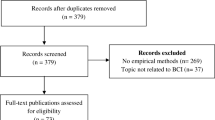Abstract
We present a novel procedure to engage the public in ethical deliberations on the potential impacts of brain machine interface technology. We call this procedure a convergence seminar, a form of scenario-based group discussion that is founded on the idea of hypothetical retrospection. The theoretical background of this procedure and the results of five seminars are presented.
Similar content being viewed by others
References
Bell, E., Mathieu, G., & Racine, E. (2009). Preparing the ethical future of deep brain stimulation. Surgical Neurology, 72, 577–586.
Belucci, S., Bütschi, D., van Eijndhoven, J., van Est, R., Ejsted, J., Gloede, F. et al. (2000). European participatory technology assessment, participatory methods in technology assessment and technology decision-making. Project Report for DGXII.
Clausen, J. (2010). Ethical brain stimulation—neuroethics of deep brain stimulation in research and clinical practice. European Journal of Neuroscience, 32, 1152–1162.
Gavelin, K., Wilson, R., & Doubleday, R. (2007). Democratic technologies? The final report of the nanotechnology engagement group (NEG). London: Involve. http://www.involve.org.uk/democratic-technologies/.
Glannon, W. (2009). Stimulating brains, altering minds. Journal of Medical Ethics, 35, 289–292.
Haselager, P., et al. (2009). A note on the ethical aspects of BCI. Neural Networks, 22, 1352–1357.
Godman, M., & Hansson, S. O. (2009). European public advice on nanobiotechnology—four convergence seminars. Nanoethics, 3, 43–59.
Hansson, S. O. (2007). Hypothetical retrospection. Ethical Theory and Moral Practice, 10(2), 145–157.
Jebari, K. (2013). Brain machine interface and human enhancement—an ethical review. Neuroethics (forthcoming).
Kados, R. C., et al. (2012). The neuroethics of non-invasive brain stimulation. Current Biology, 22(4), R108–R111.
Lebedev, M. A., & Nicolelis, M. A. (2006). Brain–machine interfaces: Past, present and future. Trends in Neurosciences, 29, 536–546.
Palm, E., & Hansson, S. O. (2006). The case for ethical technology assessment (eTA). Technological Forecasting and Social Change, 73, 543–558.
Phillips, L. (2012). Nanotechnology: Armed resistance. Nature, 488, 576–579.
Roeser, S. (2011). Nuclear energy, risk, and emotions. Philosophy and Technology, 24, 197–201.
Vidal, J. (1973). Toward direct brain–computer communication. Annual Review of Biophysics and Bioengineering, 2, 157–180.
Acknowledgments
This project was performed as part of ETHENTECH a, 7th Framework Program (Science & Society Co-ordination Action) funded by the European Commission in 2010.
Author information
Authors and Affiliations
Corresponding author
Rights and permissions
About this article
Cite this article
Jebari, K., Hansson, SO. European Public Deliberation on Brain Machine Interface Technology: Five Convergence Seminars. Sci Eng Ethics 19, 1071–1086 (2013). https://doi.org/10.1007/s11948-012-9425-0
Received:
Accepted:
Published:
Issue Date:
DOI: https://doi.org/10.1007/s11948-012-9425-0




